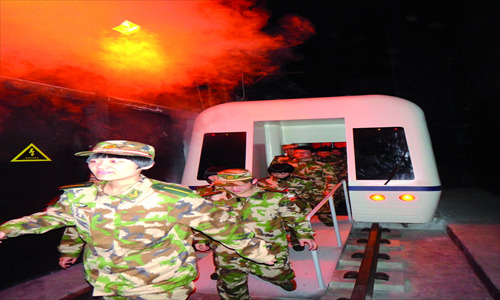
A group of students simulate how to escape in the event of fire
With both the news this weekend of a fire in a hutong house in Xicheng district and the onset of spring, a very dry season in the city, concerns have been raised about fire hazards in Beijing. For those who want to know more about safety in the event of an emergency, the China Fire Museum in Xicheng district is therefore a good port of call.
The museum was opened to the public last November, with an exhibiting space of around 9,500 square meters. On display are items from ancient China to the present day, all about certain hazards in China. Lifestyle set off to explore this place.
Get involved
The museum is spread across four floors and divided according to historical period and function. Hao Ziqiang, who works at the museum, explained that the basement, displayed as two floors on the map, is where the interactive displays are and aims to shed light on disasters like fire accidents and earthquakes and how people can protect themselves in the event of an emergency. One display, for instance, is a film about a fire hazard that is aired in a small cinema. Once the movie is done, the audience then become part of their very own fire hazard. A smoke-like gas is released and fills up the cinema and corridor. People are told to escape from the area as quickly as possible through a corridor to another exit. Infrared rays are installed along the way to highlight whether you have adopted a good means of escape or not. At the end of the activity, participants are given a rating.
Another interesting interactive element is the earthquake simulator. It consists of a bar with a counter, tables, chairs, a painting and glasses. You can either sit or stand in the room and then the ground will shake to the extent that the painting will fall off the wall. The intention is to make you understand the degree to which an earthquake of a certain level can affect the environment and yourself. "An earthquake of around level five on the Richter scale will make you stumble on your feet," Hao explained. "We could theoretically simulate an even higher level earthquake, but it might not be safe for those visitors who are youngsters or elderly," he added. On that note, those aged over 70 or with heart problems are advised against participating in some of the interactive sections.
Calm before the storm
In direct contrast to the interactive section, the historical section is a more sedate exhibition space. The journey starts thousands of years ago, when people in China first started using fire for cooking. One exhibit of a bundle of earth shows an original campfire of ancient Beijingers. The flints on display are actually still being used by certain groups in southern China.
There are also mini drum towers here, which were used to send warning signals and assemble people together in the event of fire in many cities in ancient China.
Other interesting items include devices that were used to put out fire in the past. One typical device is a bamboo manual pump, which is made of a bamboo tube which stores water inside, with a handle on one side and a spout on the other.
However, in the event of a huge fire, the effectiveness of this device was limited. For the most part, the control of fire was largely due to locality, architectural design and building materials, as opposed to tools.
Mini models show how an ancient place like Lin'an, today's Hangzhou in Zhejiang Province, took advantage of water in the city to stop fire spreading. Meanwhile, the architecture of Wu Liang Dian, a city established in 1123 in Shanxi Province, was constructed mainly with bricks and tiles that were fireproof.
It was not until the Qing Dynasty (1644-1911) that a really powerful device for putting out fire was launched. This took the form of a huge manual water pump that needed four to five people to operate it. "With people standing on both sides of the machine to press and release the handle, water was squeezed out from the body of the machine to create a powerful spray," Hao said. "It could reach at least thirty meters away." Hao explained that the museum has eight original devices like this.
There is plenty more to explore in this museum. We decided to leave other parts as a surprise for you to discover yourself though.
China Fire Museum
Address: 70 Guanganmen Nanjie, Xicheng district
Opening hours: 9 am-5 pm (closed on Mondays and Tuesdays)
Tel: 6626-7929
Admission: free

Copyright ©1999-2011 Chinanews.com. All rights reserved.
Reproduction in whole or in part without permission is prohibited.